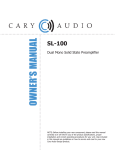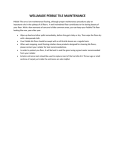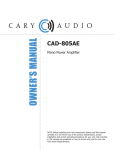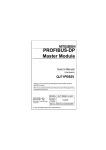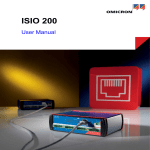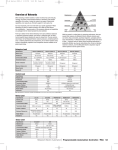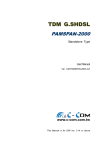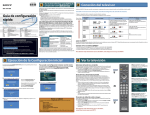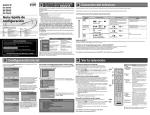Download Arc Pig User`s Manual
Transcript
Owner’s Manual Copyright 2014 Arc Pig Co. Beaumont, TX. All rights reserved. Pig and Arc Pig are trademarks of Arc Pig Co. 1 THIS IS A PRETTY GOOD WARRANTY For thirty days after purchase, if you are dissatisfied for any reason we will refund the cost of the Pig. For one year after purchase, your Arc PigTM is warranted against failure for any reason. During this period we will repair or replace the Pig at our sole discretion. We don't care why it failed. If you drop your Pig into a wood chipper, we will fix it or replace it. Just tell us the truth. Caveats You must ship us a recognizable carcass at your expense. Ship it “Delivery Signature Required” so if it never arrives, everyone will know who to blame. We pay shipping back to you via UPS ground. To get your money back within thirty days, you must return your Pig in good condition. Except it is okay if you dog-eared the owner's manual. If you break more than one Pig doing something stupid, we will charge you $100 to fix the second one. So don't be a jerk. But if the problem is our fault, we will keep fixing until we get it right. Probably we will get it right the first time. We will not pay for anything beyond fixing your Arc Pig. Act accordingly. The Arc Pig radiates powerful electromagnetic interference, which can confuse or damage nearby electronic devices. It is your responsibility to ensure that all nearby devices, including your welder, can tolerate HF. My Pig Serial Number is:_________________ Date of Purchase: _________________ 2 CONTENTS This is a Pretty Good Warranty ............................................ 2 Welcome .......................................................................... 4 Scope of this Manual .......................................................... 4 What is the Pig? ................................................................ 5 Hazards ............................................................................ 6 General Hazards of Welding ................................................ 9 Operation ....................................................................... 10 Welders and Torches ........................................................ 11 Strap-On Thumb Trigger ................................................... 12 Cables and Setup ............................................................. 13 Maintenance ................................................................... 14 Disassembly .................................................................... 15 Overheat ........................................................................ 16 Protecting Your Welder From RF ........................................ 17 Weak Spark .................................................................... 18 Troubleshooting ............................................................... 19 Symbol Glossary .............................................................. 20 Schematic ....................................................................... 21 Specifications .................................................................. 22 Technical Support ............................................................ 22 FCC Declaration of Conformity ........................................... 23 3 WELCOME Congratulations on acquiring an Arc PigTM, the best arc starter available anywhere. The Pig offers outstanding performance and ground-breaking flexibility. Extensive market research1 has revealed that a person who owns an Arc Pig is likely to be independent, self-assured, male, and not interested in this introductory drivel. Your Pig offers the following useful features: ● ● ● ● ● ● ● ● ● ● ● ● ● Powered entirely by your welder. No wall plug. Works with any TIG or stick up to 60Hz. 250A at 60% duty Inline, draggable design Prevents rectification Strap-on trigger included with purchase Minimal maintenance Audible alert when $3 spark gap wears out Full power spark with arbitrarily long cables FCC-approved EMI with arbitrarily long cables 5 lbs Won't rust Sexy SCOPE OF THIS MANUAL This manual describes the Pig, including more information than you really need. This manual will not teach you how to weld, because I suck at welding. But with a Pig I suck less, and enjoy it more. 1 No market research was conducted. 4 WHAT IS THE PIG? The Arc Pig is a high-frequency welding arc starter and arc stabilizer. It wires into your weld cables, and gooses your weld voltage with HF (High Frequency) sparks. The sparks have low current, but their voltage is high enough to leap the weld gap and start an arc without touching the workpiece. While you weld, the Pig monitors your progress and instantly restarts your arc when your elbow is jostled by the invisible fairies. You may hear your Pig crackle as it restarts your arc faster than you can see. The Pig needs no wall plug. It draws all its power (about 30 watts) from your weld cables. It works with most TIG or stick welders intended for handheld use, EN or EP, CC or CV, DC or AC 25-60Hz. The Pig contains a Tesla coil. When it fires, it makes a buzzing noise. This is the spark gap, and a reminder your torch is doing something interesting. While you press the trigger you get effective continuous fire. The Pig’s continuous fire is particularly effective because it fires as voltage approaches the AC half-cycle peak. If weld current is already flowing, HF has no effect (even with aluminum) so the Pig does not bother. The Pig also works with DC. The Pig lets you TIG-weld aluminum with any AC welder, up to 60 Hz. The Pig’s no-touch start prevents tungsten contamination, and its effective continuous fire can improve your bead (by preventing arc rectification.) Be advised you can still benefit from other features of high-end TIG welders, such as heat control and AC frequencies above 60 hertz. 5 HAZARDS The Pig's HF output is not painful. If you carelessly touch your electrode, you will feel only the normal, unpleasant zing from your weld voltage. However, if you almost touch your electrode, the HF spark will leap through the air to your skin. This looks interesting, tingles like continuous static electricity, and will eventually give you a small, deep burn. The Pig is powered by weld voltage, which is safer than mains voltage. In addition, the Pig's high internal voltage cannot leak into your weld cable, for the same reason you cannot lift yourself by your bootstraps. Nevertheless, welding is not safe, and the Pig may become hazardous due to malfunction or design flaws. We promise only that the Pig's designer uses a Pig himself, and rarely bothers to wear gloves. But he might be an idiot. Obvious hazards of the Pig include: ● The Pig makes sparks. ● The Pig makes high voltage. Less obvious hazards include, but are not limited to: ● The Pig induces high-voltage transients in wires. ● The Pig draws current intermittently, which can momentarily boost weld voltage. ● 6 Caution: The Pig makes sparks Do not use the Pig in the presence of flammable gas. In fact, when air is flammable you should avoid most welding-related activities. Do not use the Pig to illuminate fuel tanks. Caution The Pig generates high frequency and high voltage Do not touch the HF spark. I have touched it dozens of times, with no obvious ill effect, but it will probably kill you. If HF energy reaches you by arcing through the air, or through a thin wire, its energy could focus to a tiny patch of skin and burn you deeply. If your glove has a hole, HF could arc through and burn you before you know it. Be extra careful if you have numb spots. Caution Water + Electricity Water could connect hazardous internal voltage to the trigger. Water will cause misfire, and wick into wires to corrode connections. If you wet your Pig, remove its outer tube (the printing can't take the heat) and dry the innards overnight in the oven at 160F (no hotter!) with foil on the lower shelf to block radiant heat. Caution The Pig can boost weld voltage The Pig draws current intermittently, which can boost the voltage of some welders. The Pig monitors itself, to ensure it does not raise weld voltage to unsafe levels, but this monitoring could fail. Always insulate yourself from weld voltage. 7 Caution Magnetic Fields and Electromagnetic Interference The Pig induces sub-microsecond spikes up to thousands of volts in nearby wires. These transients are not perceptible to humans, but will confuse or destroy some electronic devices, possibly from a distance of several yards. Do not operate the Pig in a flying airplane, or when you visit Grandpa in intensive care. If your body contains implanted electronics, you should probably stick with gas welding. Every welder manufacturer knows you might use HF, so a well-made welder will not be damaged. But we do not guarantee your welder is well made. See instructions for protecting your welder on Page 17. To reduce electronic interference, ground everything in your shop, and cover the windows with grounded wire mesh. Some people claim exposure to fluctuating magnetic fields, such as those generated by the Pig, is harmful. If you are not willing to assume the personal risk of exposure to magnetic fields, then you should not arc weld. To reduce your exposure to magnetic fields: • Tie your cables closely together. Route both cables on the same side of your body. • • Encase your body in iron or nickel. • Keep a safe distance while Sancho does your welding. 8 GENERAL HAZARDS OF WELDING QUICK OVERVIEW The hazards of welding are extensive, and not all of them are described here. No sensible person would weld anything. DANGER Electricity can stop your heart! Insulate yourself! DANGER Arc light will sunburn any part of your body! It can sunburn your eyes from a long distance! Sunburn can permanently damage your eyes! Sunburned eyes really hurt! For a long time! Gas goggles are not dark enough for arc welding! DANGER Do not breathe the fumes! DANGER Welding is hot! Molten metal flies everywhere! Wear lots of thick leather! Do not weld near stuff that can catch fire! Do not weld over flooring your wife cares about! Even ceramic tile! Trust me on this! 9 OPERATION Suggested Technique: Position the electrode 1/8” from the workpiece. Press the trigger and move straight in until the arc ignites. Leave the trigger pressed through the weld. Power Switch (Lack Of): The Pig has no On/Off switch. It cannot interrupt your weld current, and its blower runs all the time. But it only sparks when you press the trigger. Overheat: The Pig's overheat alarm works like the overheat light in your car. It means you have already done some damage, and if you keep going, something bad will happen. Handles: The Pig is designed to be dragged or dangled by weld cables, but do not pull too hard. You will know you pulled too hard when you hear a cracking noise. Polarity: The Pig does not care about polarity. However, for a hot spark, connect the Torch stud to your torch. If you connect the torch stud to your workpiece, your spark will be weak. If you connect the torch stud to your welder, your welder may be destroyed by HF. Voltage Sensing: At power-up, the Pig beeps for 1/8 second while it measures your welder's voltage. This is how the Pig knows when your weld voltage is near its maximum, which is the best time to fire the HF spark. Lift Start: Disable lift start, because it interferes with the Pig's startup calibration, and may even withhold the power the Pig needs to operate. To disable lift start, you may need to switch your welder to “Stick” mode. 10 WELDERS AND TORCHES QUICK OVERVIEW The Pig works with most welders up to 60 Hz, and with any torch that does not contain electronics or motors. DELICATE ELECTRONIC WELDERS The Pig broadcasts HF energy to everything, including your welder. A wellmade welder will not be damaged, but if you have doubts, see instructions for protecting your welder on Page 17. WELD VOLTAGE The Pig accepts AC or DC, CC or CV, EN or EP, and adjusts automatically to your welder's voltage. Warning: Do not plug the Pig into a wall outlet. It will refuse to spark, and it lacks safety features for mains-powered devices. FREQUENCY The Pig can fire 50-120 spark bursts per second. Thus it will fire every half cycle for AC frequencies between 25 and 60 HZ. For DC, the Pig will fire roughly 70 bursts per second. For AC below 25Hz or above 60Hz, the Pig will attempt to fire at useful moments, but we do not guarantee performance. MIG The Pig's HF output may damage a spool gun. 11 STRAP-ON THUMB TRIGGER The trigger straps to your torch, and lies under your thumb. If it dangles it tangles, so the trigger wire should be tie-wrapped to your weld cable, and also to your torch handle so the thin wire will not flex. We make two trigger types: pushbutton and toggle. The pushbutton is more comfortable and rugged, but the toggle lets you move your thumb to other torch-mounted controls. Or you can make your own trigger with any mechanical switch. To mount the trigger, the secret is to press it hard against your torch while you pull the tie-wrap very tight. This trigger design does not satisfy my sister. She complains about how it looks, and prattles on about those flat plastic switches on laser sights. I note that my design resists molten steel spray, and can be felt through welding gloves. The trigger is like me: ugly but lovable. But she has a point about the wire, which is alarmingly thin and not a proper color. I apologize, and note that it was free. It also offers you a flexible stranded core, coated with silver, then PTFE, then metal braid, then abrasion-resistant, no-snag FEP. The finished wire is thin enough to lie comfortably beneath your hand, yet it fends off hot slag and is strong enough to swing your Pig around your head. Still, that color. You should cover it with a cable sheath. 12 CABLES AND SETUP The PigTM does not require special weld cables, but cracked insulation will let your spark leak out. Strap on the trigger before you cut your torch cable, to get the length right. Shield gas and cooling water must be routed around the Pig. If your cable is the two-part type, then route the gas tube like in the picture below. For one-part or watercooled cable you will need adapters. Buy our adapters or make your own. See our simple instructions at ArcPig.com/adapters. 13 MAINTENANCE REGULAR MAINTENANCE After a few years, you should inspect the insulation on the high-voltage wire. (The wire that connects to the spark plug.) We think the silicone insulation will last a long time, but we won't know for sure until it has been a long time. In the meantime, for most users, the Pig requires no maintenance except to tighten the nuts and clean the blower. The exception, for some users, is the spark plug. SPARK PLUG The spark plug is good for a lifetime of arc strikes, but will eventually be eroded by continuous fire. You can easily recognize continuous fire, because your Pig has to buzz constantly to keep your arc ignited. This happens only with low-voltage AC. The spark plug is a Champion CJ7Y, available everywhere for less than $5. Do not substitute, because similar-looking plugs increase their sparkover voltage too much as they erode. A heavily-eroded plug sparks harder, which will reduce your Pig's life. For best reliability, check the plug every 40 hours of continuous fire. Replace it when the electrode is worn off. When the Pig attempts to spark and fails, it squeaks. Occasional misfires are normal, but constant chittering indicates a failing spark plug. How to Adjust the Spark Gap Use pliers to rip off the hook So it looks like this 14 DISASSEMBLY Disassemble the Pig by disconnecting the input cables, then remove the little Phillips screw and slide out the internals. Do not operate the Pig without its protective shell, because the internal high voltage is dangerous and not adequately insulated. Reassembly Start with the little screw. Align it by twisting the black bumper. Tighten the nuts to 120 inch-pounds so the studs won’t spin. Don’t go KingKong on the nuts, because you are strong enough to break the brass stud. When tightened correctly, the input studs are the same length as the output stud. The internal spark gap voltage really hurts 15 OVERHEAT QUICK OVERVIEW Casual users cannot overheat the Pig, because the Pig can handle more current than any welder from Home Depot. After six minutes of arc time at 250 Amps, you must let the Pig cool for at least four minutes with the power on, or fifteen minutes with the power off. At 200 Amps, the Pig can operate continuously. In extreme hot weather, allow more cooling time. SOME OVERHEAT FACTS The Pig is substantially cooled by thermal conduction through your weld cables. So for heavy welding, use big cables. The Pig's current rating assumes AWG 1 cables. The Pig cools faster with its blower. After heavy welding, try to leave your welder turned on for five minutes. Do not rely on the Pig's thermal alarm for routine duty-cycle compliance. The thermal alarm sings when the electronics reach 160 F, but those electronics are thermally isolated from the power cable, so the power cable may already have reached dangerously high temperatures. This will shorten the Pig's life and could eventually create a hazard of unknown but perilous nature. The Pig will shut down if you manage to overheat its high-voltage coil with prolonged continuous fire. But it probably won't happen, because the Pig has more stamina than you. 16 PROTECTING YOUR WELDER FROM RF QUICK OVERVIEW As of this writing, Arc Pig Co. is not aware of any welder that requires RF protection. If you find one, please contact us. We routinely operate Pigs beside our smart phones, laptops, oscilloscopes, voltmeters, cameras, power supplies and aged parents, with no problems. But we do not guarantee you will get the same happy result. THE BROADCAST THREAT The Pig sends HF through your torch cable, which inevitably broadcasts some of the HF energy as radio waves, which spread outward to induce HF in nearby wires, including the cables to your welder. A well-made welder (even the $159 Harbor Freight inverter box) will be protected by filters. If you doubt your welder, you can protect it with two capacitors, ceramic or poly-film, size 50 nanofarads (0.05 microfarad.) Larger capacitors add no benefit, and could damage an inverter welder. Use the capacitors to connect your welder's output terminals to its metal chassis, as shown in orange. Consult with the manufacturer before adding output capacitors to any square-wave or exotic-waveform welder. 17 WEAK SPARK If your spark is weak, or the arc won't strike, check the following: Burnback, or electrode tip covered with slag. Give it a tap. Ground clamp not connected to workpiece Yeah, it happens. Output cable length Long cables dissipate HF. Ideally, the Pig's output cable will be 8-25 ft. To work farther from your truck, use long cables between the truck and Pig. Cable insulation If your output cable insulation is cracked, the spark can leak out. Reversed connection The output stud is for your torch. If you connect it to your ground clamp, the spark will be weak. Broken ferrite rod This will only happen if you drop your Pig farther than three feet. So don't do that. FERRITE ROD The ferrite rod will survive a three-foot drop, but a larger shock might break it. If that happens, the spark will be weak. The ferrite rod runs through the coupling coil (the big copper helix.) To find it, trace the wire from the spark plug. The rod is hiding inside a protective fiberglass tube that cost me $1 per inch. To inspect the rod, you will have to disconnect the spark plug wire and cut some rubber insulation. For a replacement rod, contact us at Arcpig.com. We might make fun of you. But we won't charge you more than $50. 18 TROUBLESHOOTING Symptom Cause Solution Overheats quickly, exhaust vent won't blow out a match Fan clogged or failed Clean or replace fan Singing Overheat Give it a rest Fan but no HF Broken trigger Fix it Capacitive spoofing Move weld cables Chirp or chittering noise when firing Spark for three minutes Spark gap to clean the plug. failed or fouled If that fails, replace the spark plug. Rolls closer when Demonic Move to Detroit my back is turned possession Weak spark after replacing spark gap Resistor plug Use Champion CJ7Y Loose wire Check the plug Weak spark Various See previous page Burnback Low weld power Tap electrode tip Tighten connections Try smaller electrode Arc hard to start 19 SYMBOL GLOSSARY This section included by law. MIG or wire welder Your welding torch Your workpiece (Ground) clamp Alien invader, possibly malevolent Trigger Something you should not weld AC or DC power Lift Start 20 SCHEMATIC 21 SPECIFICATIONS Current Capacity: 250A @60% duty, 200A at 100% duty. Input Voltage: 24 VRMS-130Vpeak, DC or AC 25-60Hz. Firing Rate: 50-120 Hz. Power Consumption: 30W Peak Output Voltage: 12KV into 220pF. Max Altitude: 15,000 Ft (4800M) Operating Frequency: low MHz, varies with weld cables Suggested Output Cable: 8 ft. Input Cable Length: Unlimited Input Capacitance: 50nF (plus startup surge.) Enclosure Protection: IP21S Power Connectors: 3/8”-16 studs Trigger Switch Any mechanical SPST Dimensions: 5” X 5” X 10”, 5.1 lbs TECHNICAL SUPPORT For help on issues not covered in this manual, visit arcpig.com, or send inquiries to [email protected], or call us at 409-234-2652. Do not ask us for marital advice. 22 FCC DECLARATION OF CONFORMITY Arc Pig This device complies with Part 18 of the FCC Rules. Responsible Party: Arc Pig Co. 575 19th St, Beaumont TX 77706. 23























